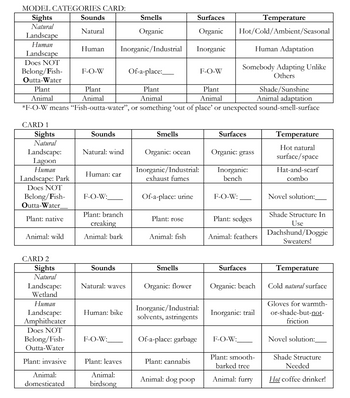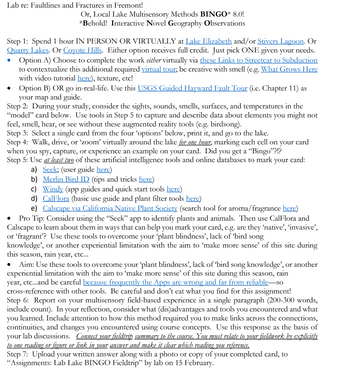
Applications and Investigations in Earth Science (9th Edition)
9th Edition
ISBN: 9780134746241
Author: Edward J. Tarbuck, Frederick K. Lutgens, Dennis G. Tasa
Publisher: PEARSON
expand_more
expand_more
format_list_bulleted
Question
I need help with this geography lab please help me write 300 words reflection and help me with the bingo card please.
Please help me with this assigment it doesnt have to be accurate I really need help

Transcribed Image Text:MODEL CATEGORIES CARD:
Sights
Natural
Landscape
Human
Landscape
Does NOT
Belong/Fish- F-O-W
Outta-Water
CARD 1
Sights
Natural
Landscape:
Lagoon
Human
Landscape: Park
Does NOT
Belong/Fish-
Outta-Water_
Of-a-place:______
Plant
Plant
Plant
Plant
Animal
Animal
Animal
Animal
*F-O-W means "Fish-outta-water", or something out of place' or unexpected
Plant: native
Animal: wild
CARD 2
Sights
Natural
Landscape:
Wetland
Human
Landscape:
Amphitheater
Does NOT
Belong/Fish-
Outta-Water
Sounds
Natural
Plant: invasive
Animal:
domesticated
Human
Sounds
Natural: wind
Human: car
F-O-W:
Smells
Organic
Inorganic/Industrial
Plant: branch
creaking
Animal: bark
Sounds
Natural: waves
Human: bike
F-O-W:
Plant: leaves
Animal:
birdsong
Smells
Organic: ocean
Inorganic/Industrial:
exhaust fumes
Of-a-place: urine
Plant: rose
Animal: fish
Smells
Organic: flower
Surfaces
Organic
Inorganic
Inorganic/Industrial:
solvents, astringents
Of-a-place: garbage
Plant: cannabis
Animal: dog poop
F-O-W
Temperature
Hot/Cold/Ambient/Seasonal
Human Adaptation
Somebody Adapting Unlike
Others
Shade/Sunshine
Animal adaptation
sound-smell-surface
Surfaces
Organic: grass
F-O-W:
Inorganic:
bench
Plant: sedges
Animal: feathers
Surfaces
Organic: beach
F-O-W:
Inorganic: trail
Plant: smooth-
barked tree
Animal: furry
Temperature
Hot natural
surface/space
Hat-and-scarf
combo
Novel solution:
Shade Structure In
Use
Dachshund/Doggie
Sweaters!
Temperature
Cold natural surface
Gloves for warmth-
or-shade-but-not-
friction
Novel solution:
Shade Structure
Needed
Hot coffee drinker!

Transcribed Image Text:Lab re: Faultlines and Fractures in Fremont!
Step 1: Spend 1 hour IN PERSON OR VIRTUALLY at Lake Elizabeth and/or Stivers Lagoon. Or
Quarry Lakes. Or Coyote Hills. Either option receives full credit. Just pick ONE given your needs.
Option A) Choose to complete the work either virtually via these Links to Streetcar to Subduction
to contextualize this additional required virtual tour; be creative with smell (e.g. What Grows Here
with video tutorial here), texture, etc!
●
Or, Local Lake Multisensory Methods BINGO* 8.0!
*Behold! Interactive Novel Geography Observations
• Option B) OR go in-real-life. Use this USGS Guided Hayward Fault Tour (i.e. Chapter 11) as
your map and guide.
Step 2: During your study, consider the sights, sounds, smells, surfaces, and temperatures in the
"model" card below. Use tools in Step 5 to capture and describe data about elements you might not
feel, smell, hear, or see without these augmented reality tools (e.g. birdsong).
Step 3: Select a single card from the four 'options' below, print it, and go to the lake.
Step 4: Walk, drive, or 'zoom' virtually around the lake for one hour, marking each cell on your card
when you spy, capture, or experience an example on your card. Did you get a "Bingo"?!?
Step 5: Use at least two of these artificial intelligence tools and online databases to mark your card:
a) Seek; (user guide here)
b) Merlin Bird ID (tips and tricks here)
c) Windy (app guides and quick start tools here)
d) CalFlora (basic use guide and plant filter tools here)
e) Calscape via California Native Plant Society (search tool for aroma/fragrance here)
Pro Tip: Consider using the "Seek" app to identify plants and animals. Then use CalFlora and
Calscape to learn about them in ways that can help you mark your card, e.g. are they 'native', 'invasive',
or 'fragrant'? Use these tools to overcome your 'plant blindness', lack of bird song
knowledge', or another experiential limitation with the aim to make more sense' of this site during
rain year, etc...
●
this season,
Aim: Use these tools to overcome your ‘plant blindness', lack of ‘bird song knowledge', or another
experiential limitation with the aim to 'make more sense' of this site during this season, rain
year, etc...and be careful because frequently the Apps are wrong and far from reliable so
cross-reference with other tools. Be careful and don't eat what you find for this assignment!
Step 6: Report on your multisensory field-based experience in a single paragraph (200-300 words,
include count). In your reflection, consider what (dis)advantages and tools you encountered and what
you learned. Include attention to how this method required you to make links across the connections,
continuities, and changes you encountered using course concepts. Use this response as the basis of
your lab discussions. Connect your fieldtrip summary to the course. You must relate to your fieldwork by explicitly
to one reading or figure or link in your answer and make it clear which reading you reference.
Step 7: Upload your written answer along with a photo or copy of your completed card, to
"Assignments: Lab Lake BINGO Fieldtrip" by lab on 15 February.
SAVE
AI-Generated Solution
info
AI-generated content may present inaccurate or offensive content that does not represent bartleby’s views.
Unlock instant AI solutions
Tap the button
to generate a solution
to generate a solution
Click the button to generate
a solution
a solution
Knowledge Booster
Recommended textbooks for you
 Applications and Investigations in Earth Science ...Earth ScienceISBN:9780134746241Author:Edward J. Tarbuck, Frederick K. Lutgens, Dennis G. TasaPublisher:PEARSON
Applications and Investigations in Earth Science ...Earth ScienceISBN:9780134746241Author:Edward J. Tarbuck, Frederick K. Lutgens, Dennis G. TasaPublisher:PEARSON Exercises for Weather & Climate (9th Edition)Earth ScienceISBN:9780134041360Author:Greg CarbonePublisher:PEARSON
Exercises for Weather & Climate (9th Edition)Earth ScienceISBN:9780134041360Author:Greg CarbonePublisher:PEARSON Environmental ScienceEarth ScienceISBN:9781260153125Author:William P Cunningham Prof., Mary Ann Cunningham ProfessorPublisher:McGraw-Hill Education
Environmental ScienceEarth ScienceISBN:9781260153125Author:William P Cunningham Prof., Mary Ann Cunningham ProfessorPublisher:McGraw-Hill Education Earth Science (15th Edition)Earth ScienceISBN:9780134543536Author:Edward J. Tarbuck, Frederick K. Lutgens, Dennis G. TasaPublisher:PEARSON
Earth Science (15th Edition)Earth ScienceISBN:9780134543536Author:Edward J. Tarbuck, Frederick K. Lutgens, Dennis G. TasaPublisher:PEARSON Environmental Science (MindTap Course List)Earth ScienceISBN:9781337569613Author:G. Tyler Miller, Scott SpoolmanPublisher:Cengage Learning
Environmental Science (MindTap Course List)Earth ScienceISBN:9781337569613Author:G. Tyler Miller, Scott SpoolmanPublisher:Cengage Learning Physical GeologyEarth ScienceISBN:9781259916823Author:Plummer, Charles C., CARLSON, Diane H., Hammersley, LisaPublisher:Mcgraw-hill Education,
Physical GeologyEarth ScienceISBN:9781259916823Author:Plummer, Charles C., CARLSON, Diane H., Hammersley, LisaPublisher:Mcgraw-hill Education,

Applications and Investigations in Earth Science ...
Earth Science
ISBN:9780134746241
Author:Edward J. Tarbuck, Frederick K. Lutgens, Dennis G. Tasa
Publisher:PEARSON

Exercises for Weather & Climate (9th Edition)
Earth Science
ISBN:9780134041360
Author:Greg Carbone
Publisher:PEARSON

Environmental Science
Earth Science
ISBN:9781260153125
Author:William P Cunningham Prof., Mary Ann Cunningham Professor
Publisher:McGraw-Hill Education

Earth Science (15th Edition)
Earth Science
ISBN:9780134543536
Author:Edward J. Tarbuck, Frederick K. Lutgens, Dennis G. Tasa
Publisher:PEARSON

Environmental Science (MindTap Course List)
Earth Science
ISBN:9781337569613
Author:G. Tyler Miller, Scott Spoolman
Publisher:Cengage Learning

Physical Geology
Earth Science
ISBN:9781259916823
Author:Plummer, Charles C., CARLSON, Diane H., Hammersley, Lisa
Publisher:Mcgraw-hill Education,